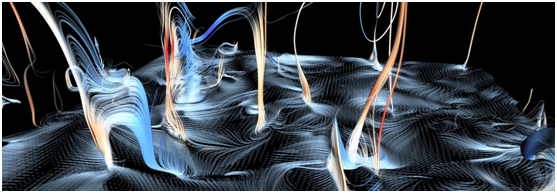The motion of vortices like typhoons, tornadoes, and ocean currents has been revealed following recent breakthrough research by Chinese scholars, after finding inspiration from the movement of microscopic pollen particles.
Professor Keqing Xia (Mechanics and Aerospace Engineering) has led his research team in collaboration with Professor Jinqiang Zhong of Tongji University. They have made a significant breakthrough in the grasp of vortex motion. Their research was published in the high-impact academic journal, Science Advances (IF = 13.116), under the title, “Vortices as Brownian particles in turbulent flows.”
Fluid flows in whirls to form vortices, the most common form of flow structure in nature. However, the movement of vortices has puzzled scientists for a long time Understanding how vortices move is vital for understanding numerous aspects of nature. They include ocean currents, cyclones, and the vortical structures in planetary scales. The motions of vortices dictate how energy and matter are transported from one place to another.
Einstein was the first person to provide the theoretical explanation for the diffusive movement of pollens in 1905. Langevin expanded on Einstein’s theory in 1908. He predicted that within a short timescale, the pollens would exhibit ballistic motion before their diffusive motion.
However, “pure” Brownian motion, in the Langevin sense, has never been observed in liquid systems, as a result of the friction that arises from motion within the fluid. That creates long-range hydrodynamic interactions and prevents the pure nature of Brownian motion.

Figure 1. Streamline of Taylor vortices
Thanks to both high-precision experimental measurements and computer simulations, the researchers have discovered the simple rule behind the vortex motion in the very disordered turbulent flow. The researchers found inspiration in the intriguing particle motion at the microscopic level. They performed their study in a rotating Rayleigh-Bénard convection, which is a paradigmatic laboratory model for studying thermally driven turbulence. They have tracked the motion of the so-called Taylor vortices (Figure 1) in thermal turbulence. Their results show the direct transition from the ballistic to the diffusive motion of vortices.
The findings have far-reaching implications. The movement of vortices appears to have “memory,” as the motion changes from the predictable ballistic to unpredictable diffusive one. One important implication of this “memory” characteristic concerns the motion of Taylor vortices existing in Earth’s liquid metal outer core. They play a crucial role in forming the Earth’s magnetic field. The study estimates that these Taylor vortices will perform ballistic motion within hours to years, such that one can predict their motion based on history.
Dr. Kai Leong Chong is the first author of the paper. The co-correspondent authors are Keqing Xia and Jinqiang Zhong. SUSTech and Tongji University are the co-correspondent units. Additional contributions came from the Chinese University of Hong Kong (CUHK).
The research was supported by the National Natural Science Foundation of China (NSFC), the Hong Kong Research Grants Council (RGC), the Hong Kong Doctoral Scholarship Scheme, a SUSTech Start-up Fund, and an NSFC/RGC Joint Research Grant.
Article link: https://advances.sciencemag.org/content/6/34/eaaz1110
Proofread ByYingying XIA
Photo ByDepartment of Mechanics and Aerospace Engineering, Yan QIU